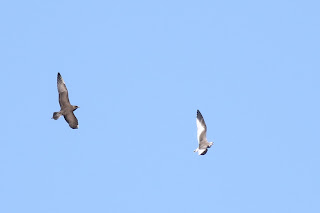Skies were overcast as we met at the Stormy Petrel II (late) Saturday morning. Myrtle Warblers were eating bugs in the lights at the marina and we could hear them overhead. Since the sun it so late to rise in the fall we didn't meet until 06:30, but by the time we made it to Hatteras Inlet, the sun was peeking out of the clouds and we headed offshore in choppy seas left from the wind the night before. Winds were light from the north west and we found some shearwaters on the shelf in addition to cooperative Atlantic Spotted Dolphins! The shearwater flock we encountered had both Cory's and Scopoli's (pictured below)in attendance plus a few Great Shearwaters. For many of our participants this was their first encounter with these species. A Pomarine Jaeger also flew by on the shelf, passing closely by ahead of the boat it gave some nice views but there was no catching it!
Just beyond the shelf break around 10:00 we found more shearwaters! It was also here that we began to pick up some Wilson's Storm-Petrels. We don't always see them at this time of year, so having over a dozen with us for most of our time offshore was spectacular! They came close each time we circled back on the slick offshore and everyone had nice views of these small stormies from the Southern Ocean. It was awhile before we saw our first Black-capped Petrel of the day, but once we found them they were very obliging. A short time later our first Pomarine Jaeger started following us in the slick, soon to be joined by another! Both looked to be near adult or adult birds, one still had a long, though tattered, tail streamer. The Black-capped Petrels put on a nice show dogging these Poms and watching their incredible, acrobatic flight kept most of us in the stern content for hours (yes, the Poms were with us for over two hours!). Audubon's Shearwaters were a bit difficult to see well, but nearshore at the end of the day we found one with a nice flock of Cory's, Scopoli's, and Greats that sat long enough for everyone to see it well! There is a lot of variation in Audubon's Shearwaters, especially in the facial and underwing patterns. Perhaps one day we will have more information about some of the different nesting populations of Audubon's in the Caribbean and we'll be able to tell more about the light form and dark form birds like we do for our Black-cappeds.
Also of note offshore were the many Yellow-rumped (Myrtle) Warblers, a high flying flock of Great Blue Herons, and a young Lesser Black-backed Gull. Thanks so much to everyone who joined us out there for our final trip of the fall, and a huge "Thank You" to all of our supporters this year! Thank you also to Steve Backus for helping Brian and I lead this trip. Our 2022 Schedule will be up later this fall! ~Kate Sutherland (all photos today are mine)
Species List for October 23, 2021
Black-capped Petrel - 19 to 21
Cory's Shearwater - 7
Scopoli's Shearwater - 17
Cory's / Scopoli's Shearwater - 255
Great Shearwater - 20 to 21
Audubon's Shearwater - 5
Wilson's Storm-Petrel - 34
Pomarine Jaeger - 4
jaeger sp. - 2
Common Tern - 2
Lesser Black-backed Gull - 1
Great Blue Heron - 5
Yellow-rumped (Myrtle) Warbler - 21 to 22
Atlantic Spotted Dolphin - 12 to 15
Bottlenose Dolphin - 42 to 52
Monarch - 1
A few Black-capped Petrel images, always a crowd pleaser, and certainly one of my favorite seabirds!
Cory's Shearwater - nice ventral and dorsal view of one individual that we sawAnother Scopoli's ventral view:
And a Cory's type shearwater. A number of birds we see have some white in p8, 9, and 10 but not 20% or more. These could be Cory's? Or poorly marked Scopoli's? I just leave them as Cory's / Scopoli's!Our other Pomarine JaegerAnd finally a couple of the offshore Bottlenose Dolphins we saw!
































